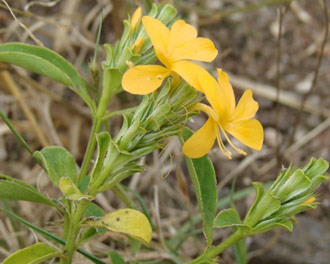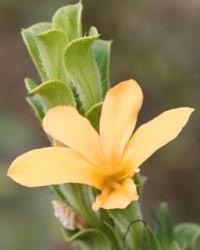Barleria senensis
Barleria senensis Klotzsch
Family: Acanthaceae
Common names: none recorded
Introduction
A hardy indigenous plant suitable for any sunny spot in your garden.

Description
Description
Barleria senensis is a much branched shrub up to 700 mm high. Mature stems are woody. Thorns are sometimes present in the leaf axils (the angle between the stem and the petiole or leaf stalk).The leaves are opposite, long-petioled, elliptic-lanceolate to oblong-lanceolate, with a base tapering into the petiole, and the leaf tips are armed with a short spine. Both sides of the leaf are dull green.
Flowers are solitary in a terminal (found at the tip) spike (flower head) which consists of spathulate (spoon-shaped) bracts which are modified, overlapping leaves. Flowers are orange. The corolla is 2-lipped: the upper lip 4-lobed, and lower lip entire. The anthers are orange. It flowers from February to June, during which time flowers appear sporadically.

When ripe, the fruit capsules are brown. They burst open to distribute the seeds.
Barleria senensis reaches maturity in 2 years.
Conservation Status
Status
None.
Distribution and habitat
Distribution description
Barleria senensis grows in well-drained soil (sometimes poor soils) in full sun in open woodlands, hills and roadsides in the Limpopo Province, Namibia, Botswana and Mozambique. It is a water-wise plant but does well in wetter conditions. It can withstand mild frost quite well.
Derivation of name and historical aspects
History
The genus name Barleria is derived from the name of a Dominican monk and French botanist, Jacques Barrelier. The genus Barleria is found throughout Asia, Africa and America. The specific epithet senensis means 'comes from Sena' on the Zambezi River in Mozambique.
Ecology
Ecology
Barleria senensis is pollinated by insects and attracts varies species of butterflies. When the seed is ripe the fruit capsule explodes when wetted to distribute the seeds in different directions.
Uses
Use
Barleria species are exceptionally suitable to stabilise eroding soil, because of their fast growth rate and seed distribution methods: hygroscopic hairs on the seeds attach the seeds to the soil surface.
Growing Barleria senensis
Grow
Barleria senensis can be propagated by seed or cuttings.
To prevent seeds being lost, they should be collected as the capsules turn brown and before they burst open.
The seeds should be planted in a mixture of two parts good soil and one part clean river sand. Place it in a shady spot in your garden and water once a week. Germination of the seeds takes place after a week. Transplant the seedlings into bags when the seedlings are more or less 100 mm high.
Cuttings should be taken in summer. Make use of plant material of the previous year's growth. Take cuttings of 120 mm. Treat them with a hormone powder and plant in a mixture of equal parts good soil and river sand. Put the cuttings in a shady place and water twice a week. Transplant the rooted cuttings after about three months into a good soil mixture.
References
- Little, J. R. & Jones, C.E. 1980. A dictionary of Botany. Van Nostrand Reinhold Company, New York, Cincinnatti, Toronto, Melbourne.
- Retief, E. & Herman, P.P.J. 1997. Plants of the northern provinces of South Africa: keys and diagnostic characters. Strelitzia 6.
- Germishuizen, G., Meyer, N.L.,Steenkamp, Y. &Keith, M. (eds) 2006. A checklist of South African plants. Southern African Botanical Diversity Network Report No.41. SABONET, Pretoria.
Credits
Willem Froneman
Lowveld National Botanical Garden
December 2011
Plant Attributes:
Plant Type: Shrub
SA Distribution: Limpopo, Mpumalanga
Soil type: Sandy, Loam
Flowering season: Late Summer, Autumn
PH: Neutral
Flower colour: Orange
Aspect: Full Sun, Afternoon Sun (Semi Shade)
Gardening skill: Easy
Special Features:
Horticultural zones










Rate this article
Article well written and informative
Rate this plant
Is this an interesting plant?
Login to add your Comment
Back to topNot registered yet? Click here to register.